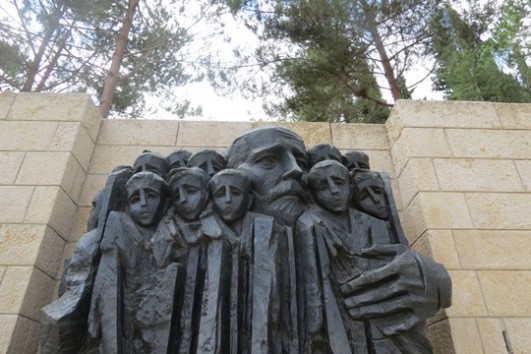Exploring Jerusalem’s Holocaust museum allows us to understand the way in which the Zionist narrative deals with the destruction of European Jewry. But is it the whole story? Part eight of Yuval Ben-Ami’s journey through the Holy Land’s most popular tourist sites.
In the early years of the 11th Century, the Holy Land was taken over by ISIS. The religious militants came from the north, their faces covered. They pillaged every town through which they passed, beheading “heathens” and abducting women. Their sense of self-righteousness and the blessings of fundamentalist clergymen made them entirely blind to their atrocities.
They did not call themselves “ISIS” or “ISIL” or even “The Islamic State.” They called themselves Crusaders, and are celebrated today as noble knights. As part of this series, I had the idea of visiting Acre, capital of the second Crusader kingdom, checking out its various crusader-themed sites and discussing how we romanticize history.
Eventually, I chose to stick to the list of sites chosen by my trusty editor Michael. It skips Acre, but does feature Yad Vashem, Jerusalem’s Holocaust museum. On the way there I wonder whether that would be the perfect place to explore the theme of “romanticizing history.” Clearly, Yad Vashem does not cleanse wrongdoers. Nor does it diminish history. The museum provides a very serious educational experience, and is invaluable in preserving the memory of the Holocaust. As a teenager I spent hours in Yad Vashem’s archives searching through sheets of microfilm for survivors among my grandfather’s family members who disappeared from southern Slovakia in the early 40s, almost without a trace.
At the same time I cannot escape the way in which Israeli culture ceremonializes the memory of the Holocaust, boxing it away it from the rest of history and distilling our emotional reaction with its every mention. It seems to me that Israeli politicians appear to ceaselessly use this emotional reaction in order to enhance our sense of vulnerability and ostensible dependence on their polices.
We also beautify the Holocaust, leaving out that which we find “unbecoming” of the canonized memory. Consider the experiences of sex slaves in the camps. Women survivors who have been through unimaginable horrors must go on feeling ashamed, hiding their stories and the tattoos that attest to them. Their pain is almost never told. My great aunt was enslaved in a different fashion: working in a Siemens factory that operates until this very day. The dehumanized slaves did not receive basic living conditions and died of typhus. My great aunt died on the day of liberation. I don’t hear much talk about that either. We now buy Siemens; we even cook our meals with their appliances. Discussing “labor camps” without mentioning brand names is considered more “becoming.”
The way Israel deals with the Holocaust has changed over the years from silent shock, through the catharsis of the Eichmann trial, to our present day discourse. There was always bias in how it was told. No society or individual can deal with such a catastrophe without some degree of moderating manipulation. This is why Anne Frank’s diary is so popular. We can deal with one girl. A million children – that is a lot harder. This is probably why “Schindler’s List” was shot in black and white, providing some distance, and why it focuses on the story of a man who risked himself to save others, and not on that of a killer.
Reaching for the light
Yad Vashem (the name can be generally translated as “a memorial and a name”) is a large campus situated on a hill on the green, western outskirts of Jerusalem. The grounds host various structures and pieces of public art. The most central of those is the museum, designed by architect Moshe Safdie is the 1990s.
Safdie’s museum is a prism of concrete that runs through the hill. Visitors zig zag through the prism, exploring the interactive exhibition while gradually nearing the light at the end of the tunnel. Having gone through, they stand on a balcony overlooking the beauty of the Jerusalem corridor. The tunnel summarizes the Zionist narrative vis-a-vis the Holocaust quite briefly: it was a hard time, but it’s over. Now we have our own country and never again will we be subject to such evil.
Read parts one, two, three, four, five, six and seven of ‘The Beaten Path.’
Having emerged from the tunnel, visitors frequently head for the children’s memorial, a striking installation in which the light of three candles is multiplied through a play of mirrors into a galaxy of small flames. They are also invited to walk down the hill and visit “the valley of the communities” — a stone labyrinth, whose walls are adorned with the names of towns and cities where Jews once lived (and may still live). Otherwise they may or climb up to Mt. Herzl, Israel’s principle military cemetery and the pantheon of the nation’s greats, from Herzl to Rabin.
Along with the prism, the hill also presents the Zionist narrative. At its foot is the Jewish past – the Diaspora — which the Israeli perspective views as a thing of history. Halfway up is the Holocaust, the turning point. And at the very top? The Arab-Israeli conflict, with its own death toll, representing the present. (Sadly and perhaps prophetically, the hill possesses no higher peak; that would be reserved to honor a future of peace and normality.) The diaspora is a maze — a claustrophobic reality. The Holocaust is a straight corridor: a single, solid, defining event that leads elsewhere. The cemetery is an open air garden, somber but free, and of course – superior.
So the story goes
I am here today with one of the groups I guide. We try to give them as much time as possible to explore on their own. I take that time for myself. After visiting the museum I walk through the grounds of Yad Vashem, visiting my favorite spots. Most of them are dedicated to acts of bravery: the tree planted in honor of the Danish nation, the moving statue of legendary teacher Janus Korczak and the children of his orphanage. Korczak, who like the children was Jewish, was given several opportunities to escape Poland. He chose to remain with his children and ended up being carted to the camps along with them.
Sitting at the foot of the moving depiction of Korczak hugging the children, I realize that Yad Vashem does not romanticize the Holocaust. It neither over-dramatizes nor significantly under-dramatizes it. Instead, it frames it.
Consider Korczak’s story. He was not the only one who stayed with the children and met his death at the hands of the Nazis. There was a woman there too, Stefa Wilczynzka, Korczak’s partner in running the orphanage. Wilczynzka had actually moved to Palestine in the 1930s, when dark clouds began to cover Europe. She became a member of Kibbutz Ein Harod, but chose to leave in order to care for Jewish children in Poland. Like Korczak, she was offered refuge and refused. She was murdered in Treblinka in 1942.
We need the Holocaust to be a story, and a well-defined one at that. We need it to be made up of familiar characters. In a typically male-centered telling of history, Wilczynzka was forgotten. Though she is commemorated elsewhere by Yad Vashem, her removal from the pages of history is cast in bronze in the major Korczak monument, which presents a solitary man hugging a group of children.
We need the Holocaust to be a story, a well-defined story. We need it to have a beginning. When did the Holocaust begin? I return to the museum in order to find out which exhibit is placed first in the museum’s chronological presentation. It is a plaque describing the Nazis’ rise to power in 1933. The next exhibit, however, takes us back in time with a plaque dating back to the Middle Ages, which describes historical anti-Semitism in Christian traditions. Yad Vashem admits that the story goes back — that Hitler did not emerge out of nowhere. But it chose to start in 1933 and only then look back, squeezing the history leading up to the Holocaust for the sake of coherence.
When does the Holocaust end? The victory of the Allies and the liberation of the camps ended the extermination of the Jews and of other populations (the latter are only briefly referred to among the exhibits). Is that really the right point to insert a “The End” caption? Was the war of 1948 not a ripple effect of World War II? Is contemporary worldwide anti-Semitism unrelated? What about the ongoing psychological and political scars left by those 12 years on Jews, Germans and others? Is the Holocaust entirely unrelated to later atrocities, such as the Rwandan Genocide and the Balkan massacres of the 1990s?
Nearly a decade ago an Israeli guide named Itamar Shapira stood on the concluding, comforting balcony with a group. He told them that in the serene landscape before them once stood a village named Deir Yassin, and that in 1948 Israeli militias carried out a massacre there. To my understanding Shapira did not compare the event to any horror of Holocaust. He did, however, link it to the events that preceded it in Europe. German acknowledgement of the Holocaust was enormously important to both nations. Shapira expressed a hope that Israeli recognition of Palestinian pain would result in a healthier future for both societies.
Shapira was promptly fired from Yad Vashem. He told the story wrong, drawing the wrong conclusions. Framing a narrative makes history more accessible, more easily conveyed. But it also prevents that same history from being explored. It bars us from learning from it. We have framed the Holocaust too well — so well that we have barely become capable of asking the most difficult, humanist questions it brings up. Questions that the rest of humanity has been dealing with for over 70 years. As Jews we relate to the victims of the Holocaust, with whom we share so much. As humans, however, we almost never relate to its perpetrators, with whom we share so much. This is unfortunate. We have so much to learn, so much to be wary of.



